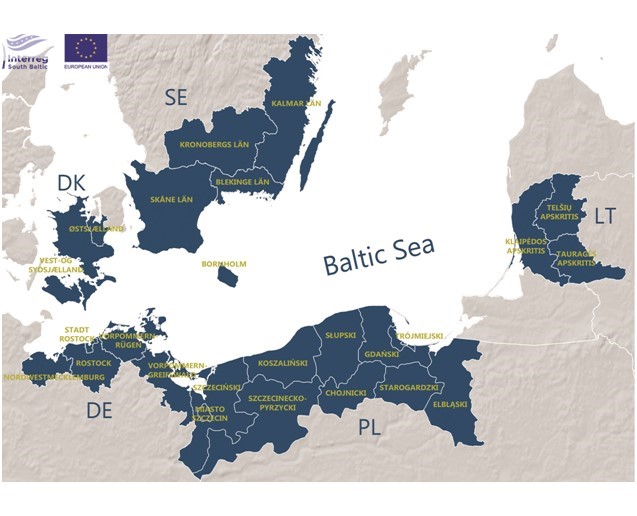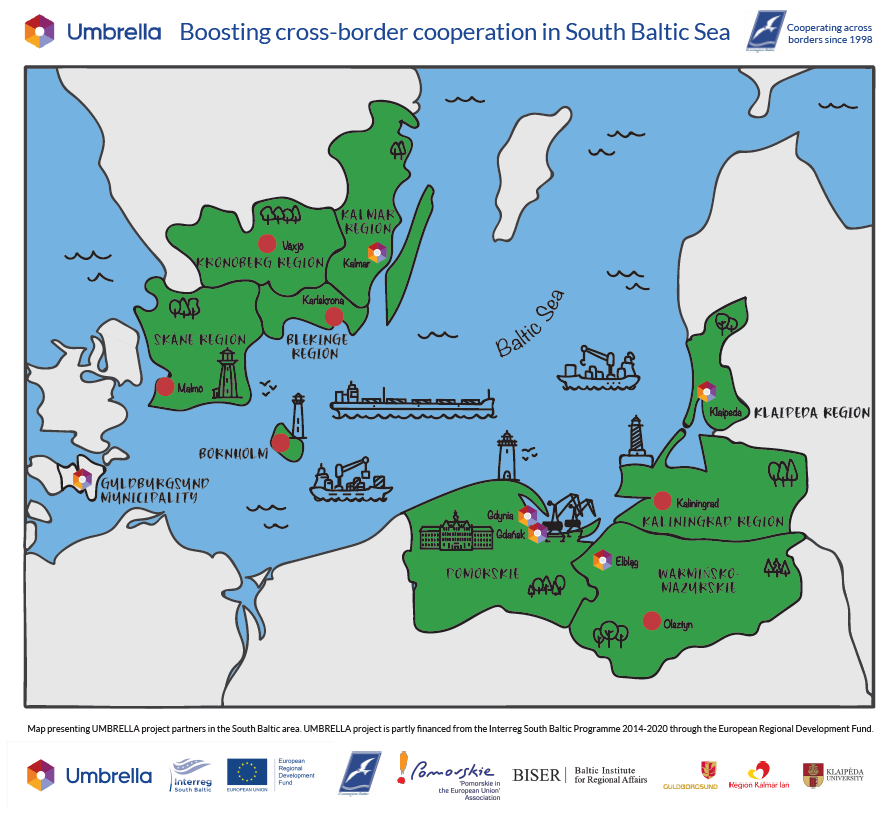The Interreg South Baltic Programme aims at unlocking South Baltic’s potential for blue and green growth through cross-border cooperation between local and regional actors from Denmark, Germany, Lithuania, Poland and Sweden. Building on the maritime character of the Programme, “blue growth” addresses the economic potential of the Baltic Sea for growth and jobs across the shores of the South Baltic. At the same time, “green growth” underlines the need to pursue the path of economic growth in balance with the environment, in particular by utilising South Baltic’s rich natural and cultural heritage in a sustainable and preserving manner.
A bit of history…
From 2004 Euroregion Baltic carried out a lobbying campaign aiming at the acquisition of a CBC area status in the new EU financial perspective 2007 – 2013. The rationale behind this ambition was to facilitate the implementation process of its common strategy and Joint Development Programme.
The first step in the lobbying campaign was to issue the position paper by which all the ERB member regions expressed their common support for Euroregion Baltic to acquire the CBC status, and for all its members to be able to fall under the CBC eligibility criteria. This position paper was adopted and disseminated in August 2005. It was then presented in a series of follow-up meetings in 2005 and 2006 with the regional and national representations of the ERB member countries to the European Union, members of the EU Parliament, EU Regional Policy Commissioner, Ms Danuta Hübner and her personnel.
Another major contribution to the success of the campaign was the support offered by the Swedish government, facilitated by the active internal lobbying of the three ERB member regions in Sweden: Blekinge, Kalmar and Kronoberg. As early as in Spring 2006 the national governments in Denmark, Poland and Sweden agreed to create this new cross-border cooperation facility for the South Baltic area, including the Danish island of Bornholm, the Swedish regions Blekinge, Kalmar, Kronoberg and Skane, and three northern Polish regions: Pomerania, Warmia-Mazury and Western Pomerania. During the autumn 2006 Lithuania joined in with the regions of Klaipeda, Telsiau and Taurage, as well as Germany with the 10 northern regions in Mecklenburg-Vorpommern. The Polish Ministry for Regional Development was agreed to be the Programme Management Authority and a Joint Programme Secretariat was agreed to be established in the City of Gdansk. At the same time, the Programme Core Group was established writing the draft Operational Programme and including representatives of Euroregion Baltic. In addition, the national implementation group formed consisting of the representatives of all the national structures from the five countries involved in the work on the Programme, as well as the Joint Programming Committee, which in July 2007 forwarded the draft programme to the European Commission for approval.
The programme with around 61 MEUR provided by the European Regional Development Fund, was approved in December 2007. The first application round took place between 26th March and 30 April 2008.
INTERREG SOUTH BALTIC PROGRAMME

The Programme eligible area consists of the following units:
- in Germany – districts (Landkreise) of Mecklenburg-Vorpommern: Nordwestmecklenburg, Rostock, Vorpommern-Rügen, Vorpommern-Greifswald and district-free city (kreisfreie Stadt): Rostock;
- in Denmark – Regional Municipality of Bornholm and Region Zealand (subregions: Østsjælland, Vest- og Sydsjælland);
- in Lithuania – counties of Klaipėda, Tauragė and Telšiai;
- in Poland – subregions of: Miasto Szczecin, Szczeciński, Szczecinecko-pyrzycki, Koszaliński, Słupski, Starogardzki, Chojnicki, Gdański, Trójmiejski and Elbląski;
- in Sweden – counties of: Kalmar, Blekinge, Skåne and Kronoberg;
The following types of organisations can form partnerships and submit applications (non-exhaustive list):
- Public administrations and agencies;
- Public or private (having either public or non-profit character) companies dealing with communal and municipal environmental and energy management, public transport or transport infrastructure administration;
- chambers of commerce, clusters and business support organisations;
- R&D facilities and educational institutions;
- labour offices and unions, employer organisations;
- associations of public or private bodies and NGOs,
- Natural and cultural heritage protection organisations.
The ERDF funding is divided between 5 Programme priorities:
Priority Axis 1: Strengthening international activeness and innovation capacity of the South Baltic blue & green economy
- Specific Objective 1.1: Increase the presence of blue and green sector SMEs from the South Baltic area on international markets through joint cross-border actions
- Specific Objective 1.2: Improve the transfer of innovation for the benefit of blue and green sector SMEs through joint cross-border actions
Priority Axis 2: Exploiting the environmental and cultural potential of the South Baltic area for blue and green growth
- Specific Objective 2.1: Increased development of the South Baltic area’s natural and cultural heritage assets into sustainable tourist destinations
- Specific Objective 2.2: Increased use of green technologies in order to decrease the pollution discharges in the South Baltic area
Priority Axis 3: Improving cross-border connectivity for a functional blue and green transport area
- Specific Objective 3: Improve the quality and environmental sustainability of transport services in the South Baltic area
Priority Axis 4: Boosting human resource capacities for the area’s blue and green economy
- Specific Objective 4: Increase the share of skilled labour force working in blue and green economy sectors of the South Baltic area through joint cross-border actions
Priority Axis 5: Increasing cooperation capacity of local actors
- Specific Objective 5: Improve the cooperation capacity of local South Baltic area actors through participation in cross-border networks
Learn more about the current programme here: https://southbaltic.eu/
How to get funding?
- Your organisation has a legal personality;
- Your organisation is based in the eligible area (in exceptional and well-justified cases, project partners can be located outside the eligible Programme area; see section III.2 of the Programme Manual);
- Your organisation faces a challenge / an opportunity related to SME internationalisation or SME innovation, sustainable
- transport or tourism, green technologies, human resource or cooperation capacities;
- The challenge / opportunity requires joint actions across borders;
- The joint action can be accomplished by your organisation and your partner organisation(s) from (an)other Member State(s);
- The joint action will be carried out in the Programme eligible area;
- The joint action corresponds with a Programme specific objective.
Download the necessary Programme documents here:
https://southbaltic.eu/programme-documents
If you need more information or support in preparing the application or converting your idea into a project – let us know! Euroregion Baltic is a Lead Partner in Umbrella Interreg South Baltic project which aims at boosting the capacities of small and local actors in the South Baltic area to engage in CBC cooperation. You will find more info on Umbrella offer and tools including training material in the Umbrella project section on this website.


The Programme provides co-financing from the European Regional Development Fund (ERDF) for cooperation activities between two or more organisations from at least two participating Member States. The funds available for cross-border efforts that unlock the potential for blue and green growth amount to ca. 78 M EUR. The co-financing rate for Polish, Lithuanian and German beneficiaries is up to 85% of their eligible project costs, while Swedish and Danish beneficiaries receive up to 75% of ERDF co-financing. The ERDF co-financing is paid on the basis of semi-annual reimbursements.
EUROREGION BALTIC AS A KEY PLAYER FOR THE BIRTH OF THE INTERREG SOUTH BALTIC PROGRAMME
From 2004 Euroregion Baltic carried out a lobbying campaign aiming at the acquisition of a CBC area status in the new EU financial perspective 2007 – 2013. The rationale behind this ambition was to facilitate the implementation process of its common strategy and Joint Development Programme.
The first step in the lobbying campaign was to issue the position paper by which all the ERB member regions expressed their common support for Euroregion Baltic to acquire the CBC status, and for all its members to be able to fall under the CBC eligibility criteria. This position paper was adopted and disseminated in August 2005. It was then presented in a series of follow-up meetings in 2005 and 2006 with the regional and national representations of the ERB member countries to the European Union, members of the EU Parliament, EU Regional Policy Commissioner, Ms Danuta Hübner and her personnel
Another major contribution to the success of the campaign was the support offered by the Swedish government, facilitated by the active internal lobbying of the three ERB member regions in Sweden: Blekinge, Kalmar and Kronoberg. As early as in Spring 2006 the national governments in Denmark, Poland and Sweden agreed to create this new cross-border cooperation facility for the South Baltic area, including the Danish island of Bornholm, the Swedish regions Blekinge, Kalmar, Kronoberg and Skane, and three northern Polish regions: Pomerania, Warmia-Mazury and Western Pomerania. During the autumn 2006 Lithuania joined in with the regions of Klaipeda, Telsiau and Taurage, as well as Germany with the 10 northern regions in Mecklenburg-Vorpommern. The Polish Ministry for Regional Development was agreed to be the Programme Management Authority and a Joint Programme Secretariat was agreed to be established in the City of Gdansk. At the same time, the Programme Core Group was established writing the draft Operational Programme and including representatives of Euroregion Baltic. In addition, the national implementation group formed consisting of the representatives of all the national structures from the five countries involved in the work on the Programme, as well as the Joint Programming Committee, which in July 2007 forwarded the draft programme to the European Commission for approval
The programme with around 61 MEUR provided by the European Regional Development Fund, was approved in December 2007. The first application round took place between 26th March and 30 April 2008.
INTERREG SOUTH BALTIC 2007-2013
The overall objective of the South Baltic Cross-Border Cooperaton Programme was to strengthen the sustainable development of the South Baltic area through joint actions increasing its competitiveness and enhancing integration among people and institutions.
The Programme was characterised by geographically large area encompassing regions from five European Union Members States.
The area eligible for the Programme included the following NUTS III units
Denmark – Regional Municipality of Bornholm and as adjacent: Zealand sub-region;
Lithuania – Klaipeda County and as adjacent: Taurage and Telsiai Counties;
Germany – sub-regions of Mecklenburg-Vorpommern: Greifswald, Rostock, Stralsund, Wismar, Bad Doberan, Nordvorpommern, Nordwestmecklenburg, Ostvorpommern, Rügen, Uecker-Randow;
Poland – Szczecinski, Koszalinski, Slupski, Gdanski, Gdansk-Gdynia-Sopot sub-regions and as adjacent (according to the “20% rule”): Elblaski sub-region;
Sweden – Kalmar, Blekinge, Skane Counties and as adjacent: Kronoberg County
The Programme had three priorities
Priority Axis 1: Economic Competitiveness
Indicative actions within Priority axis 1 are a) entrepreneurial development, b) integration of higher education and labour markets, c) transport accessibility
Priority Axis 2: Attractiveness and Common Identity
Indicative actions within Priorityaxis 2 are: a) management of the Baltic Sea environment, b) energy saving and renewable energy, c) sustainable use of natural and cultural heritage for regional development, d) local community initiatives.
Priority 3: Technical Assistance
Technical Assistance is essential for providing effective implementation of the Programme, financing the preparatory, management, monitoring, evaluation, information, and control activities of the Operational Programme